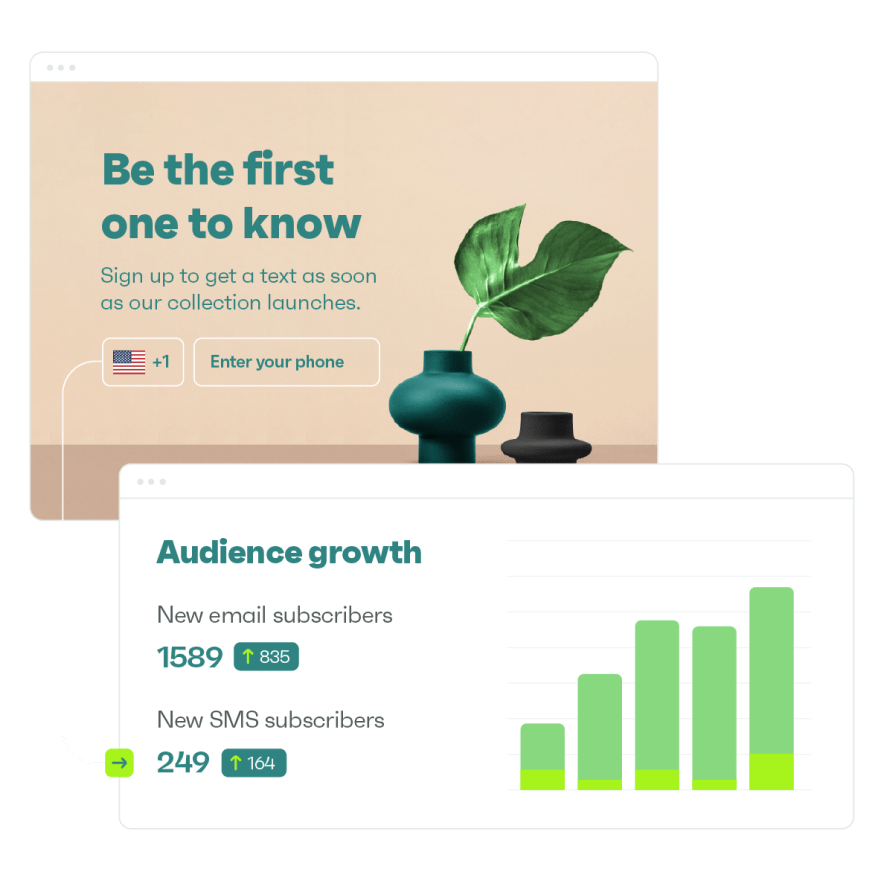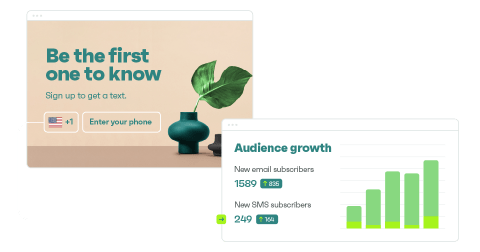Drive sales on autopilot with ecommerce-focused features
See FeaturesSo many entrepreneurs have succeeded with ecommerce. Their success stories have led everyone to believe that they can easily achieve similar results. However, that’s not always the case with dropshipping.
Due to stiff competition, evolving consumer trends, and the need for continual adaptation, success is not guaranteed.
This comprehensive guide explores how to dropship on Shopify to offer a realistic perspective to new business owners.
We’ll show you how to choose a niche for your dropshipping business and find suppliers for your online store. We’ll also show you how to differentiate your store and market your products to the right customers.
Are you ready to build a successful dropshipping business on Shopify?
Let’s get started!
What is Shopify dropshipping?
Shopify dropshipping provides a flexible way to sell physical products on your online store.
Dropshipping through Shopify doesn’t require you to physically store your product. Your products are manufactured, warehoused, and shipped by a third-party manufacturer or wholesaler.
When a customer buys a product from your store, you simply forward the order to the wholesaler, and they will ship it to the customer.
This reduces the risk of losing money since you don’t pay to acquire inventory. You also don’t have to worry about unsold products since you only order them from the wholesaler on demand.
By eliminating the trouble of managing inventory and shipping orders to customers, Shopify dropshipping has made it easier to start an online business. You can easily turn your side hustle ideas into successful businesses and earn passive income.
It’s also an easy way for business owners to test new product lines. Before making any commitments, entrepreneurs who know how to dropship on Shopify can easily test a new product’s market demand.
How does Shopify dropshipping work?
Shopify dropshipping shows the relationship between a customer-facing online store and a supplier or wholesaler of physical goods.
The online store, in this case, is designed using Shopify.
When a customer buys a product, the ecommerce store owner forwards the order to the supplier. The supplier then ships the product directly to the customer.
The image below illustrates what the Shopify dropshipping process looks like. It greatly streamlines order fulfillment to make it easier for anyone to start an online business.
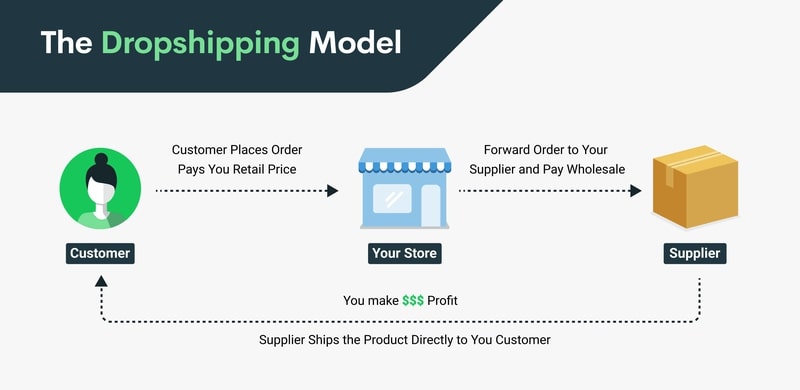
For example, you sell children’s clothing in your Shopify store. A pair of the latest baby shoes costs $20 on a supplier’s website. You can list the shoes on your online store at $50 + free shipping.
When a customer buys the shoes, you can place an order on the supplier’s website and send them the customer’s details for fulfillment. This saves the trouble of managing inventory and shipping products to customers.
From this process, it’s evident that the success of a dropshipping business depends on getting a reliable supplier who can guarantee quality products and timely delivery, which are the hallmarks of a successful online business.
Browse the app store from your account dashboard to find the best Shopify apps that connect you to appropriate suppliers.
These apps automate most of the dropshipping process, allowing you to import products and fulfill orders directly from your Shopify store.
Is Shopify dropshipping still profitable?
Before we discuss how to set up dropshipping on Shopify, you probably want to know, “Is dropshipping worth it?”
The answer? A resounding yes.
The profit margins may be low, but overall, Shopify dropshipping is profitable when done right. Some of the top Shopify stores operate on a dropshipping model, proving that there is success in this.
On average, you can expect to earn between $1,000 and $5,000 per month when you learn how to dropship on Shopify. The most successful Shopify dropshippers earn more than $100,000 per year.
So, what determines how profitable a dropshipping business can be? The key contributors include:
- Product selection: Choosing in-demand, niche products gives you more flexibility in pricing and increases your profit margins.
- Marketing strategies: Effectively promote your products online to attract customers. Marketing strategies like social media and email marketing can increase sales, which also increases profits.
- Supplier relationships: Choose reliable suppliers who deliver quality products on time to increase customer satisfaction. Additionally, build strong relationships with the suppliers to ensure smooth order fulfillment.
- Ecommerce platform: Your choice of ecommerce platform also affects how profitable your dropshipping business will be. Shopify is a user-friendly platform that can help you convert visitors into customers.
After considering all of this, make sure to set the right price to increase the profitability of your dropshipping business. The fixed markup on cost approach is probably the most effective pricing strategy for dropshipping.
This approach includes adding a fixed dollar amount or fixed percentage to the product cost to determine its selling price.
Dropshipping pricing formula:
- Fixed dollar markup: Product price = Cost of product + dollar markup
- Fixed percentage markup: Product price = Cost of product + (cost of product * markup percentage)
For example, you sell fitness equipment on your Shopify store. A supplier sells a pair of dumbbells at $25. If you add a fixed dollar markup of $25 for every pair, the selling price will be $50. On the other hand, you can use the fixed percentage markup and add a 100% markup to get a selling price of $50.
The markup will cover your selling costs, such as paying for your Shopify plan and email and domain hosting. What’s left after paying the bills is your profit.
How to start dropshipping on Shopify in 10 easy steps
Shopify dropshipping is a simple business model that removes the headaches that come with logistics. It makes it easier to start your dream business. Let’s go over the process of starting a dropshipping business on Shopify.
1. Choose a niche
The first step when creating a dropshipping business is to choose a niche. A niche is a specific market segment that caters to the needs and interests of certain users.
You wouldn’t want to sell just anything and everything on your Shopify store. Choosing a niche allows you to build a focused audience and sell products that appeal to that audience.
So, how do you choose a niche for your Shopify dropshipping business? Through market research.
Many people would advise you to build a dropshipping business around what you’re passionate about. However, you may realize nobody wants the products you’re most passionate about, making it difficult to generate sales.
That’s why it’s important to conduct market research to find profitable niches for your dropshipping business. Google is a particularly useful tool that can help you measure market demand for a product and find appropriate niches.
Google has two free tools you can use for market research: Google Trends and Google Keyword Planner.
Google Trends allows you to check the search interest for a particular phrase over time. Ideally, you want to enter a niche with a growing interest.
The illustration below shows the search interest for the term “health and fitness” over the last 12 months. The graph indicates there’s steady interest in this niche.
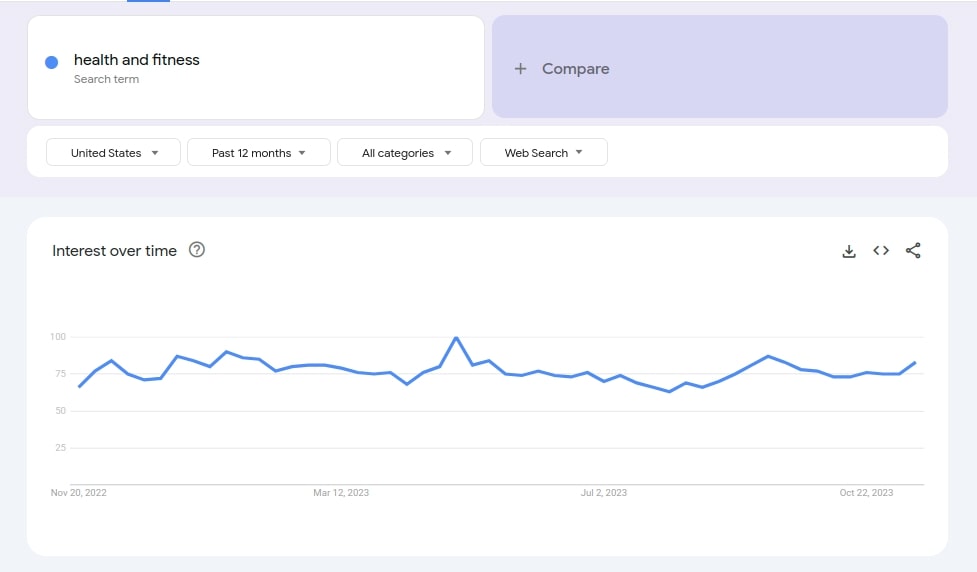
Additionally, Google Keyword Planner can help you find a profitable niche by showing you the search volume for a particular term. This information is also helpful in growing your online store through search engine optimization.
If you don’t have time to do independent research, you can pick a niche that’s already proven to be popular. Shopify research has identified that the following are the best dropshipping niches:
- Apparel and footwear
- Beauty and personal care
- Kitchen and dining
- Baby
- Pet supplies
- Home interiors
- Office products
- Tools and home improvements
- Phone accessories
- Car accessories
2. Conduct competitor research
Once you’ve identified your niche, the next step before you start dropshipping through Shopify is conducting competitor research. This step provides insights that will help you build a successful dropshipping business.
For instance, you’ll learn the marketing strategies of your competition. This will inspire you to find better ways to attract customers.
It also allows you to study your competitor’s product designs. This will help you develop creative ways to make your products stand out.
When conducting competitive research, focus on the big players in your niche. These brands receive the most attention from customers. The insights you get from their dropshipping business will help you succeed with yours.
The top ways to conduct competitive research include:
1. Google search
This should be the starting point of your competitive research. Search your primary keywords and take note of the online stores that occupy the top spots on SERPs. You can compete with these businesses and outrank them to drive customers to your site.
For example, if you want to start a dropshipping business that sells pet supplies in the US, your top five competitors are:
- Pet Supplies Plus – SERP position 1
- Chewy.com – SERP position 2
- PetSmart – SERP position 3
- 1800PetSupplies – SERP position 4
- Value Pet Supplies – SERP position 5
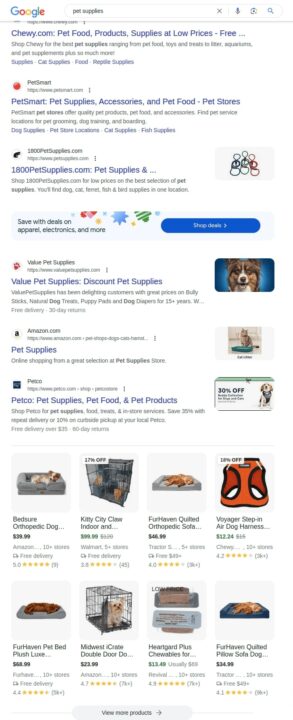
By studying how these brands promote their products, you can devise a strategy to differentiate your offerings.
2. Competitor spy tools
Tools like BrandWatch and SimilarWeb allow you to track your competitors’ online activity. They provide useful information, such as your competitors’ traffic sources and number of visitors.
3. Social media
Once you know who your competitors are, find them on social media to understand how they engage their audience. Take note of how their feed is designed and what type of content they create regularly. Additionally, study their engagement rates to know which content type is popular with your target audience.
3. Research dropshipping suppliers
Choosing dropshipping suppliers is a key step in learning how to dropship on Shopify.
These suppliers will ensure you have products to sell on your online store. They also deliver products to customers after purchase.
At this stage, you already have an idea of the products you want to sell. Now, you want to find dropshipping suppliers to provide high-quality products to sell in your store.
Luckily, Shopify comes with apps that help you find suitable suppliers for your dropshipping business. These apps are available on the Shopify App Store, and you can find them with a simple search.
The illustration below shows the search results for the term “dropshipping” on the app store.
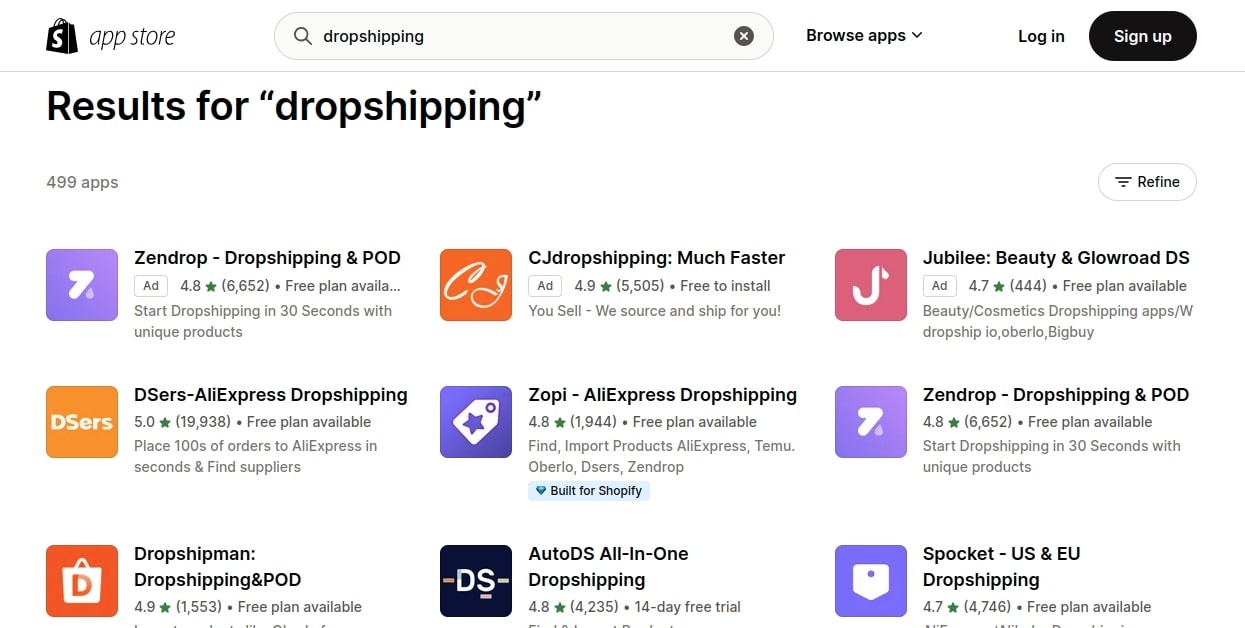
The standout dropshipping app is DSers, which has a rating of 5/5. This app connects merchants with suppliers on AliExpress. It also allows you to search for dropshippers selling a similar product to help you find the best price for your products.
Other Shopify dropshipping apps worth considering include:
- Dropshipman (4.9/5)
- CJdropshipping (4.9/5)
- Zendrop (4.8/5)
- Spocket (4.7/5)
Aside from dropshipping apps, you should also consider print-on-demand apps like Podbase and Printful. These apps connect you to suppliers who print your custom designs for products like t-shirts, mugs, and notebooks.
This will help maintain the uniqueness of your products and help you stand out in a crowded market.
4. Choose a store name
The next step in how to dropship on Shopify is choosing a name for your online store. When dropshipping through Shopify, differentiation is key to building a successful business.
That’s why choosing a unique business name that resonates with your target audience is important. Also, keep in mind that the store name will also be your Shopify domain. So, pick a well-thought-out name that best reflects your brand identity.
If you’re setting up an online store for the first time, follow these tips to come up with a good name:
- Keep it short: Come up with a short business name that’s easy to remember and pronounce. Shorter names are also difficult to misspell, making it easy for customers to find your business online.
- Be unique: Create a unique name that leaves a lasting impression on potential customers. Find out what differentiates your business and use that as an inspiration to create a distinctive name.
- Check availability: Avoid picking a business name that’s already taken. Through a simple search on Google, you can check if your preferred name is still available.
With its free business name generator, Shopify has also made it easier to brainstorm unique names for your online store.
Simply describe your business using a few words, and it will generate a list of suggestions.
In the example below, we asked the tool to suggest names for a business that sells custom apparel. The tool presented a list of 24 creative business names.
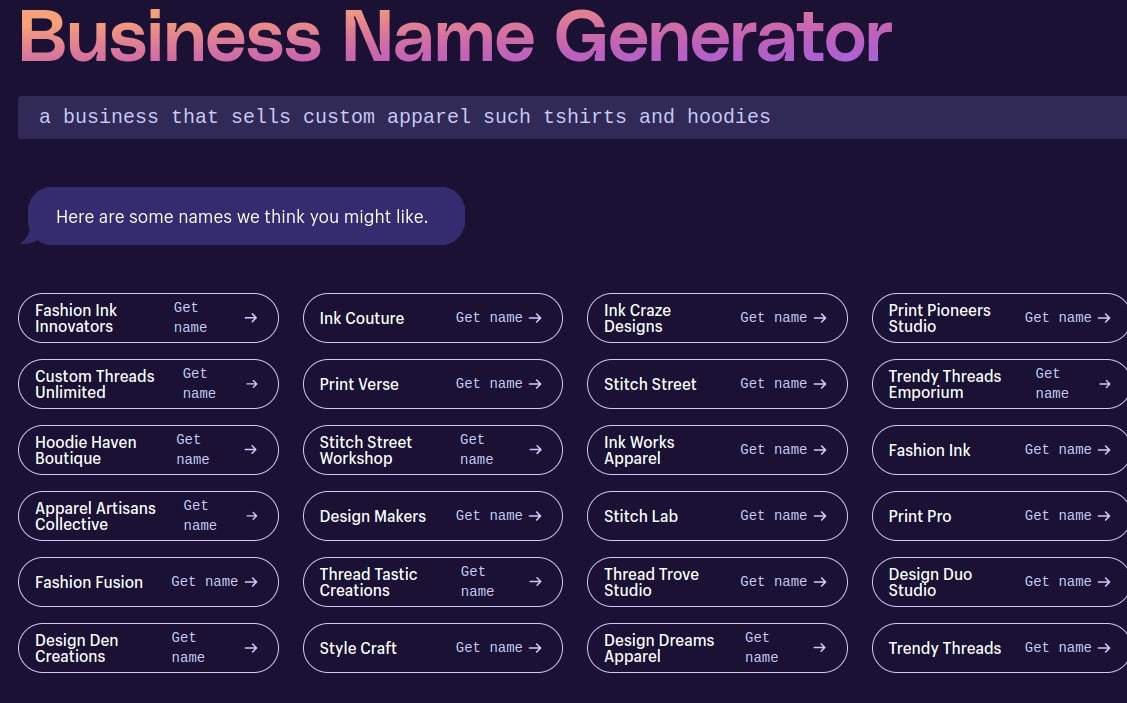
5. Create a Shopify account
This is the most essential step when setting up a Shopify dropshipping business. Shopify has made the signup process easy.
To start, visit the Shopify website and click the “Start free trial” button on the top right corner.
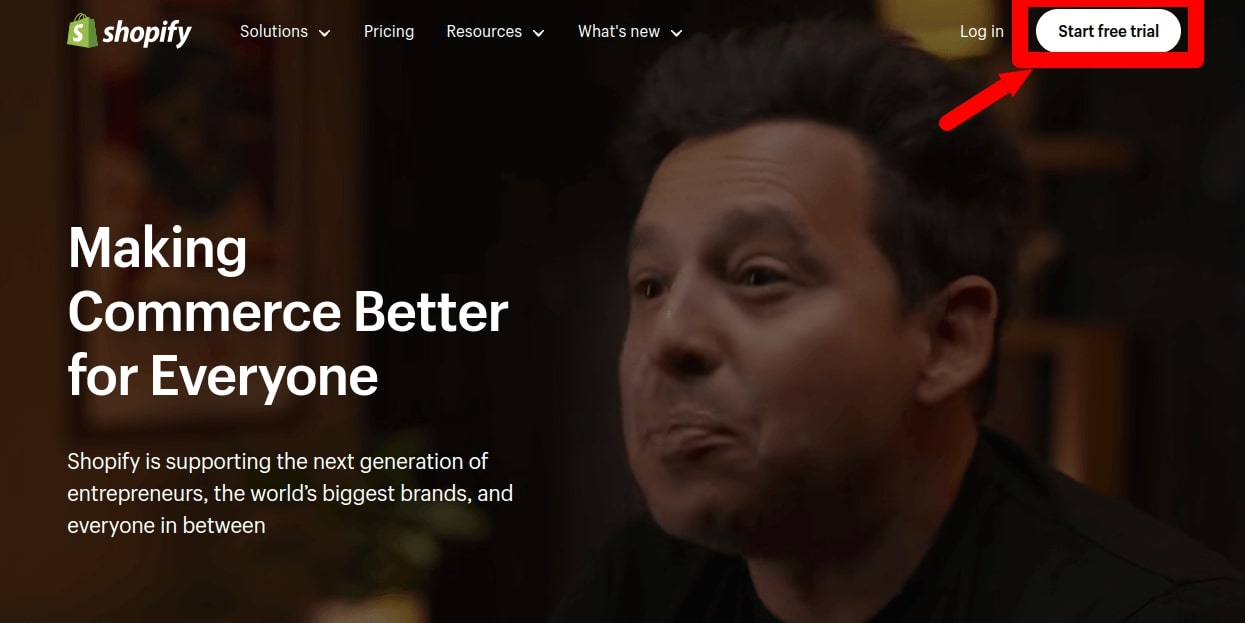
This opens a setup wizard that prompts you to provide a few details about your online store. For instance, you’ll be asked to indicate whether you’re just starting or you’ve been selling for a while.
Next, the wizard asks where you want to sell your products. You have several options, and you can select as many as you like.
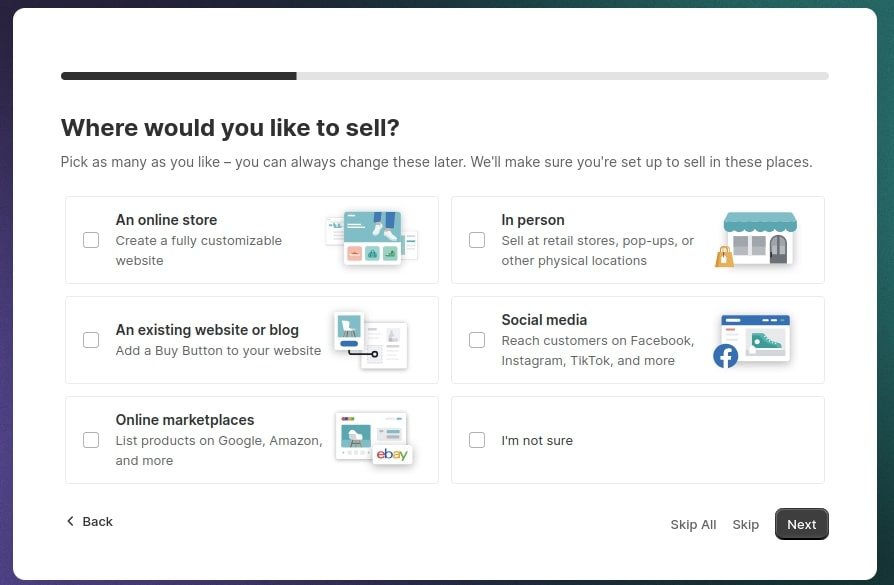
This setup is an important step in learning how to dropship on Shopify. The wizard will then ask you what you want to sell.
Since you’re starting a dropshipping business, make sure to tick the “Dropshipping products” button. Shopify uses this information to recommend appropriate apps that connect you to dropshipping suppliers.
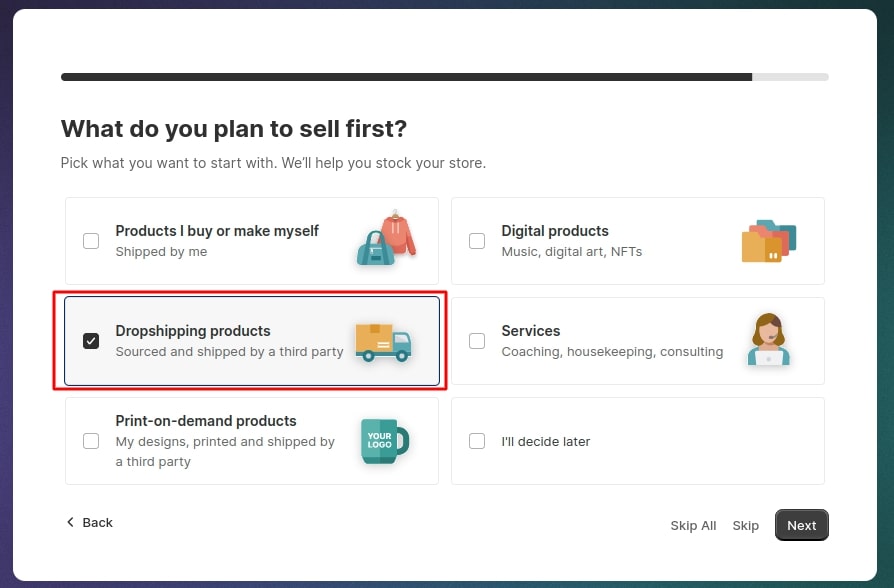
Next, indicate where your business will be located. Then, the wizard asks you to sign up with your email address, Google, Apple, or Facebook account to complete the process.
After setting up your account, you can try Shopify for free for 3 days. After this, you’ll need to choose a pricing plan that suits your business needs.
Shopify has three premium plans:
- Basic: $32 per month (ideal for new businesses)
- Shopify: $92 per month (suitable for growing businesses)
- Advanced: $399 per month (geared towards businesses with advanced needs)
6. Customize your Shopify store
This section of our guide on how to dropship on Shopify will walk you through customizing your Shopify store. After creating your Shopify account, work on your store design before you start selling.
Customization allows you to establish a visually appealing design that instantly captures attention and instill confidence in potential customers.
But before you customize your store, you need to pick a theme. Shopify has plenty of themes you can use. The themes are grouped into two categories: Free and paid.
- Free Shopify themes: Free themes are ideal for new and small businesses that are launching their first online store.
- Paid Shopify themes: Paid themes offer more design functions and robust ecommerce tools to help you do more with your online store. Prices range from $180 to $390.
To pick a theme for your store, visit Shopify’s theme store to browse the available options. Shopify has categorized the themes based on style and industry to make it easier to find a design that suits your brand.
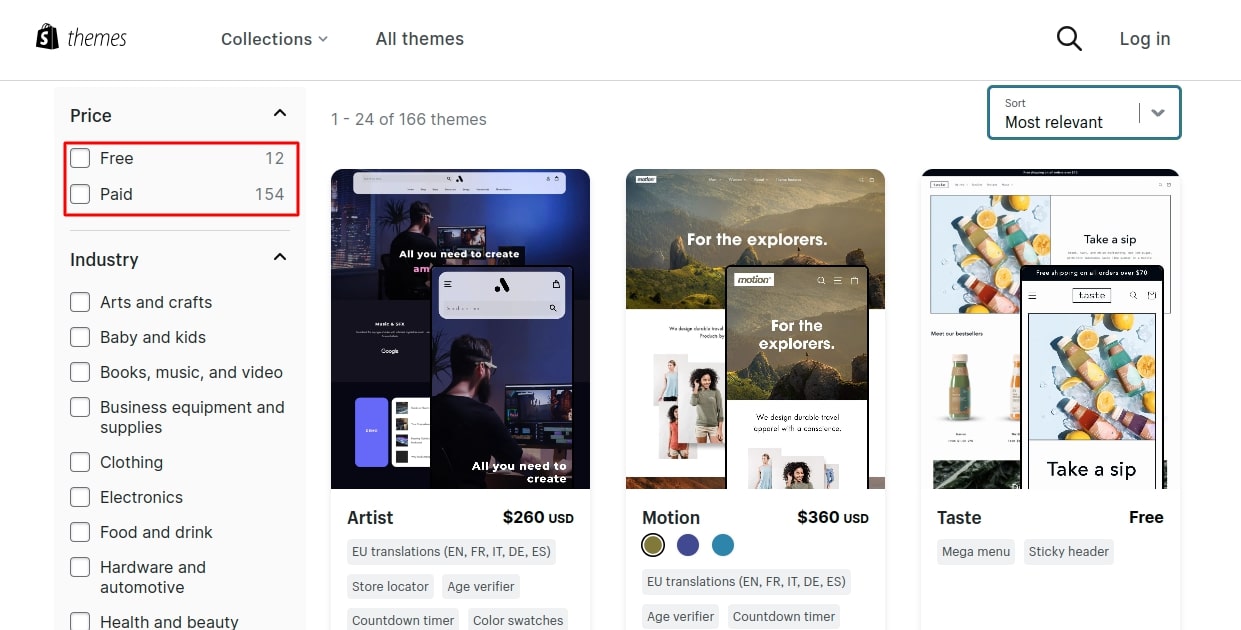
After choosing a theme, take time to customize it with your brand elements. Theme settings on Shopify allow you to edit your theme and add the following elements:
- Color palette: Change the colors on the theme to suit your brand guidelines.
- Fonts: Use your brand fonts on the theme to create a unified branded look.
- Logo: Upload your logo to establish a strong online presence.
Incorporating these elements into your store will help you create an engaging online experience for your potential leads and customers.
7. Add products to your store
Once the customization is complete, you can start adding products to your Shopify store.
Here’s how to add dropshipping products to Shopify. Start by installing a dropshipping app and browse the product list.
DSers integrates seamlessly with Shopify, so you can use it to import products to your store.
After installing the DSers app, you need to add categories for your store. Make sure to name the categories after the products you’ll be selling. For example, if you’re starting an apparel store, you can have categories like:
- T-shirts
- Hoodies
- Caps
- Jeans
With your product categories defined, search the DSers app for AliExpress products you can sell on your store. The app will provide the following information to help you make an informed decision:
- Supplier rating: Each item includes the overall rating of the supplier taken from user feedback. You can click the product to read user reviews on AliExpress.
- Wholesale cost: The app lists the wholesale price of each product to help you determine the potential profit margin.
- Number of orders: You can see the number of orders the supplier has fulfilled so far.
The image below shows how products are listed on the DSers app.
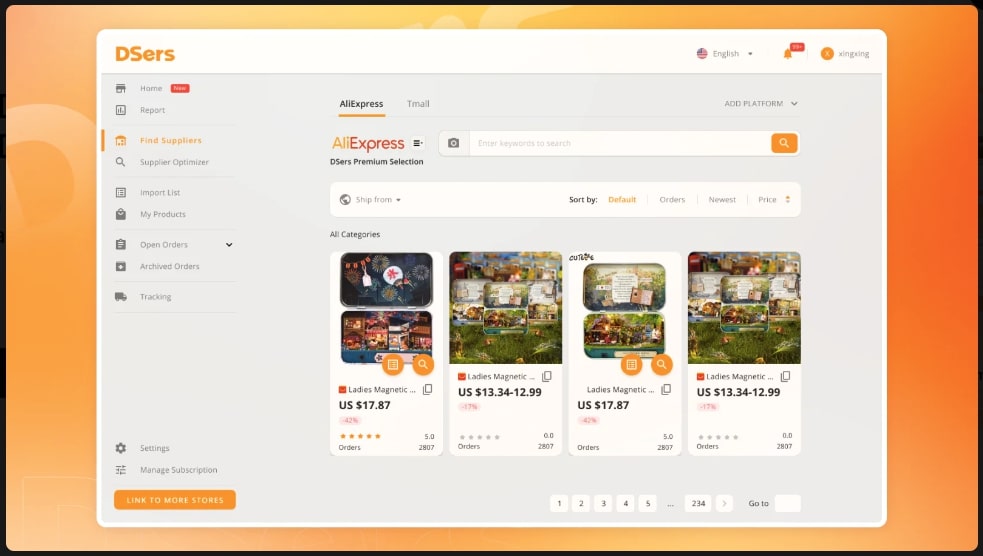
Once you’re sure of a product, you can import it directly to your store along with its product description. You can then edit the description on your Shopify dashboard and set the selling price.
8. Set up your finances
With products added to your store, you must be excited to start selling. But before you start to dropship on Shopify, set up your finances appropriately to ensure smooth business operations.
Here’s how to go about that:
1. Open a business checking account
Don’t mix your personal and business finances. Set up a separate account for your business to make it easier to track and manage your finances.
2. Get a business credit card
Make sure to acquire a business credit card that you’ll use to pay for your dropshipping inventory and other business expenses.
3. Collect sales tax
If you operate in a state that collects sales tax, make sure to set up and collect this tax from your dropshipping transactions. Get in touch with your state department to know how often you should submit the taxes you’ve collected.
9. Market your store
The next step is to market your store. You can have a beautiful store that sells amazing products, but you will struggle to generate sales if no one knows about it.
New businesses take a long time to appear on search results, so focus on proactive marketing strategies, such as:
- Social media marketing
- Paid advertising
- Influencer collaborations
- Referral programs
Think long-term when promoting your business on these platforms. Don’t just aim for immediate sales. Focus on building lasting relationships, so you can generate more sales through repeat business.
By asking for the contact details of current and potential customers, you can tell them about upcoming promotions, freebies, discounts, and more.
Omnisend stands out as a reliable platform for creating lasting relationships with your customers. The platform offers the best email marketing for Shopify. It also supports SMS marketing to provide you with an additional channel to engage your audience.
Using these two channels at the same time increases your customer touchpoints to help you generate more sales.
For instance, when a shopper abandons their cart, you can create a workflow that sends them an email reminder, followed by an SMS with a discount. This will motivate them to log back into your store to complete the purchase.
The example below illustrates how Omnisend’s integration with Shopify works to help you recover abandoned carts. After 24 hours, customers receive an SMS with a 10% discount for carts over $100. For carts below $100, they get an email encouraging them to complete their purchase.
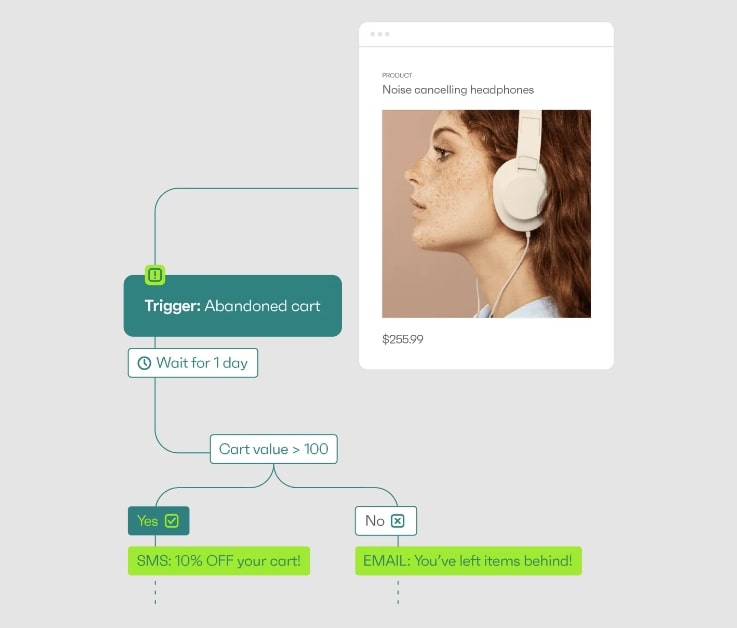
Such a multi-channel approach ensures effective customer engagement and maximizes sales for your online store.
10. Start selling
The last step on how to dropship on Shopify is to start selling.
As a new business, gaining traction will take you some time, so be patient and persistent in your efforts. Use the marketing strategies we’ve mentioned above to drive traffic to your store.
You should also use this time to take care of other important issues that relate to your business. For instance, creating your refund policy. Ensure the policy is clear and prominently displayed on your website to establish trust with customers.
Warmly, a Shopify dropshipping business that sells home decor, has a no-nonsense return policy published on its website. If customers are not happy with their products, they offer a hassle-free return or full refund within 30 days of delivery.
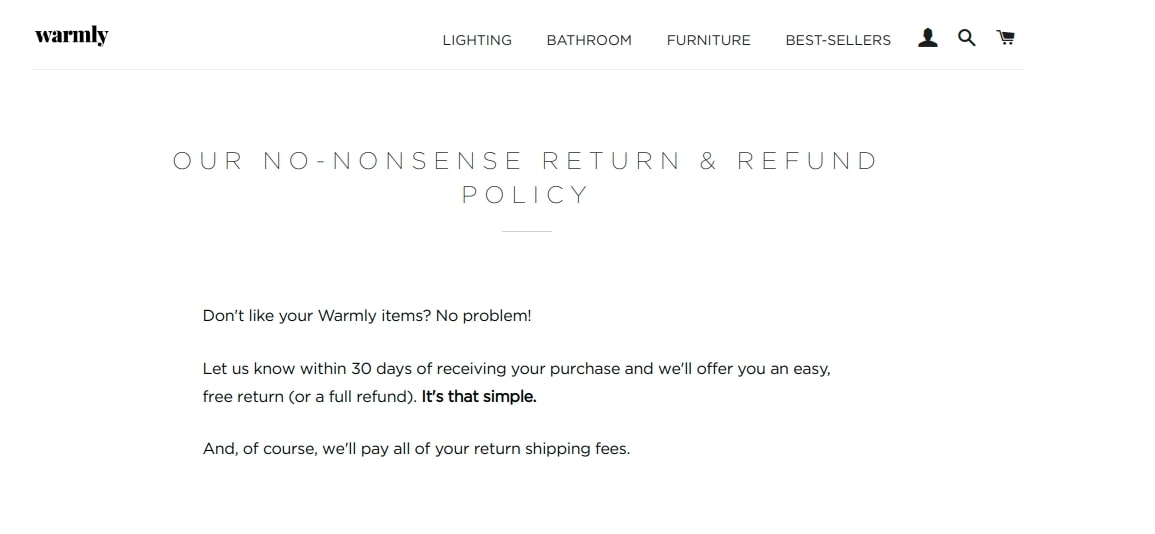
Other things you should take care of as the sales start trickling include:
- Setting up your customer support options
- Updating your product listing based on customer feedback and market trends
- Engaging your audience on social media and other channels
- Showcasing new arrivals and promotions
Proactively managing these aspects of your business will help you enhance customer satisfaction and ensure the long-term success of your Shopify dropshipping business.
Wrap up
Shopify dropshipping is an effective business model that simplifies the process of starting an online business. By delegating all the logistics functions to the supplier, entrepreneurs can reduce their upfront costs and focus on marketing their products.
This guide has shown you how to dropship on Shopify. Start by identifying a niche and researching the competition to position your store strategically.
Next, choose a unique store name and create your Shopify account. Install dropshipping apps to your online store to find suitable product suppliers.
Lastly, import the products to the store and start selling.
As you can see, the process is very simple when you follow these steps. In no time, you can launch a lucrative store to sell just about anything online.
quick links
related features
No fluff, no spam, no corporate filler. Just a friendly letter, twice a month.
